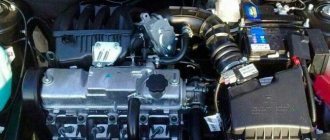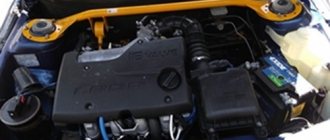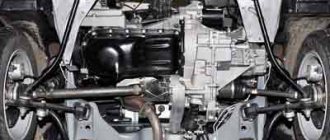The 1.8 engine Lada Vesta SV Cross is the heart of the domestic station wagon, which is one of the most important and significant parts. From this article you will learn absolutely everything about the 16-valve 1.8 Lada Vesta SV Cross engine with index 21179 - its strengths and weaknesses, characteristics, design, etc.
Let's start with a short excursion into history. About 5 years ago, a completely new 16-valve engine with index 21179 appeared on the AvtoVAZ conveyors. Outwardly it was similar to its predecessors, but inside it was very different from them.
Let's compare technical characteristics
If we compare the technical characteristics of these two engines, then in terms of choice, the advantage will be on the side of the 1.8 liter engine (model 21179): 122 horsepower versus 106 for the 1.6 liter (model 21129), acceleration to 100 km/h in 12.1 s (for the “rival” "for 12.8), the maximum speed that a car can develop is 188 km/h for a 1.8-liter engine, 178 for a 1.6-liter engine. Thus, if you are more interested in quality characteristics, then you should definitely pay attention to the first option engine. However, on the other hand, it turned out to be less practical in terms of savings.
Description of the K4M engine (Renault Logan/Sandero/Largus)
It is a development of the K7M series, with a new cylinder head, already 16 valve. There are many differences: K4M is quieter, it is more economical, there are no vibrations and many other advantages.
- expensive spare parts.
- If the belt breaks, the valve bends; it is recommended to change the belt every 60 thousand km.
- there are failures in work.
- Low-quality fuel causes the revs to fluctuate.
- troit (most often the problem is in the ignition coil, injectors or spark plugs).
- Unstable operation and floating speed are usually caused by the crankshaft position sensor or ignition coil.
If you choose between K7M and K4M, then the choice should definitely remain with the more modern and practical K4M.
What kind of oil is recommended for Lada Vesta?
Regarding savings, the manufacturer recommends filling in SAE 5W30 or SAE 5W40 oil of domestic brands:
The plant calls foreign manufacturers an alternative oil for Vesta with the characteristic 5w30:
- Mobil (5w40 is also allowed, and for new cars 0w40);
- Motul Specific DEXO s2;
- Shell HELIX HX8.
It is precisely with its lower power and volume that the 1.6-liter engine turned out to be a more economical option, because its fuel consumption is slightly lower than that of its opponent: 9.3 liters - in the city; 5.5 – on the highway; 6.9 – in mixed mode (versus 10.2/6.5/7.5 for the 1.8-liter, respectively).
Now let’s move on from dry and boring numbers to a more lively “interior”. As for the drive, there are as many as three options: the larger engine has a timing belt from the German company INA (and as you know, there is no doubt about the quality of German products), the standard 1.6-liter power unit has a regular timing belt, but There is also a similar engine from the Nissan concern H4M (with a power of 110 hp, many sources indicate 114 hp, but this is incorrect), on which a chain is already installed.
In the latter case, we can talk about the “golden mean” between quality and efficiency. Although, in the case of the practicality of the drive, the Nissan engine “jumped ahead” of both of its brothers - here you can save on consumables (the chain is, however, more expensive, but it lasts much longer, there is no possibility of bending the valves).
Renault-Nissan H4M-HR16 DE
The only foreign-made internal combustion engine in the Lada Vesta is the H4M-HR16 DE, manufactured by the joint company Renault-Nissan. Its main difference from the two above-mentioned engines is the absence of a timing belt. Instead, a chain is installed, which is much more reliable and cheaper in terms of use and repair. Engine Specifications:
- volume – 1.6 l;
- power – 114 hp;
- drive and timing – chain instead of belt;
- torque 153/4400;
- weighs 109.1 kg;
- electronic starting system;
- distributed injection;
- accelerates to 100 km/h in 12.2 seconds;
- resource 250 thousand km.
This engine consumes 92 and 95 gasoline and methane. The standard consumption in a populated area is 8.2 liters, on highways 5.4 liters, and in mixed driving 6.3 liters. Like its brothers, it adheres to Euro-5 toxicity standards. The H4M-HR16 DE engine is the most expensive among all three installed on Vesta, but also the most reliable in operation. Powerful, dynamic, comfortable, at the same time it “eats” little fuel. Distinctive features of the engine also include increased piston sizes and crank radius, improved, more economical oil passages and some other upgrades.
Perspective
It should be noted that the power unit from the Nissan concern is superior to our domestic engines both in many quality and technical characteristics and in terms of efficiency (more reliable, more durable and uses less oil). Surely, not everyone needs exactly record numbers from a car and its engine - most car owners are looking for the most advantageous combination of reliability, practicality and efficiency, and therefore in this case it is worth paying attention to the Lada Vesta with a Nissan engine.
But there is one thing, the installation of the imported H4M engine has been postponed indefinitely, apparently due to the rise in price of the model and, as a consequence, the recoupment of such an upgrade is not profitable.
There is good news, on October 20, 2022, information was received that AvtoVAZ is testing another engine on the Lada Vesta, this is a 1.4-liter gasoline turbo engine from Renault and 150 hp, we’ll find out how this will end a little later.
But in order not to further mislead the public, it is necessary to mention in a few words the combination of these engines with various types of transmissions. So, the 1.8-liter engine is installed on all three types of gearboxes used in Vesta: robotic, mechanical and automatic. A conventional domestic 1.6-liter power unit is combined with a robot and mechanics. The Nissan engine is also installed on all three types of gearboxes. As most car owners understand, a car cannot develop its full engine potential with a robotic gearbox. But the choice of gearbox remains beyond the scope of this article; among the engines, it is worth noting the 1.6-liter Nissan concern due to its higher reliability and efficiency.
Today, dealers offer only 4 versions: - 1.6L 106 hp with a 5MT gearbox and 5ST AMT - 1.8L 122 hp with a 5MT gearbox and 5ST AMT
Video comparison test of 1.6 versus 1.8 engine on Vesta:
AvtoVAZ is developing its 16-valve engines gradually, that is, step by step. When the updated Kalina family appeared in 2013, buyers were perplexed as to why they offered a 106-horsepower engine in manual versions, which differed little in design from the usual Priora engine.
The new engine was equipped with resonant supercharging, and it seemed that its presence would only have disadvantages: reliability was reduced, there was no way to connect the cable drive. But it turned out that the new engine was no worse than its predecessor: the mass air flow sensor often breaks down, and the DBP and DTV sensors almost never. There is no MAF sensor in the design of the 27th engine, which is the secret of increased reliability.
[Episode 42]Largus CROSS with updated engine
View and compare engines
closer: Help in buying a new car: .
The price of the LADA Largus with the new engine remained unchanged: the station wagon costs from 635,400 rubles, the van – from 609,800 rubles, the LADA Largus Cross version – from 689,900 rubles. This is the price of models without various discounts, with which the car will cost significantly less.
As for the features of Largus
with a power unit of 106 hp. (VAZ-21129), then about them is expanded.
The VAZ plant has been producing station wagons and vans of the Largus family since 2011. In 2014, the production of station wagons in the “Cross” body was launched. By that time, AvtoVAZ had localized the assembly of K4M engines, but not K7M, supplied by Renault.
The first of the two engines is equipped with 16 valves, and it became the basis for all trim levels of the crossover station wagon. It is this, and not the 8-valve K7M, although 8-valve internal combustion engines are more suitable for the SUV segment. In fact, the K7M engine is inferior to its 16-valve brother in both power and traction characteristics. And if the Lada Largus Cross engine had been 8-valve, neither the factory nor the buyer would have benefited from this. Let's look at the details.
Why was the 27th engine replaced with the 29th?
The VAZ-21127 engine was good for everyone, except for one thing - it complied with Euro-4 standards. For Vesta sedans produced since November 2015, this option would not be suitable. It was necessary to solve a difficult problem: to improve the environmental class without increasing the volume and without losing power. And as a result, a new family of 16-valve engines appeared in the VAZ arsenal. We are talking about motors 21129 - they really meet the latest environmental standards.
The first Vesta engine, produced by VAZ
To move to the Euro-5 standard, engine 21127 had to be modified:
- The resonant intake system, as well as the exhaust system, have been completely redesigned;
- The ECU controller (ECM) has received new firmware - even the algorithm that regulates the volume of the resonant chambers has been changed;
- Engines 21127 and 21129 have slightly different compression ratios - 11.0 versus 10.45;
- The engine suspension was also improved: it became possible to mount it on a subframe.
Engine design Lada Vesta SV Cross 1.8 21179
Engine 21179 looks like this:
And this is what a real sample looks like:
The main difference between this engine and its predecessors is the presence of a variable valve timing system. In general, this is the first AvtoVAZ engine to be equipped with such a system. But to implement it, a large number of nodes had to be modified.
Let's start with the fact that this motor is controlled by an electronic throttle. Yes, the E-GAZ system is familiar to us from the latest VAZ 2114 and Lada Priora models. But she didn’t bypass Vesta either. And there was no other option - the motor must comply with Euro 5 environmental standards, which means it cannot be done without an electronic throttle.
Next comes a modified intake manifold made of heat-resistant plastic.
To increase the volume of the combustion chamber, the height of the rise and fall of the piston was changed, for which it was necessary to change the crankshaft and connecting rod-piston group. Thanks to all the manipulations, the piston stroke was increased from 75.6 to 84.0 mm. To compensate for friction losses due to the increased piston stroke, the diameters of the crankshaft connecting rod journals were reduced by 4.8 mm (from 47.8 to 43 mm). The crankshaft oil channels have also been changed, and a class mark for the main and connecting rod bearings is now applied to the ends of the CV for more accurate engine assembly.
The connecting rods are made using breaking technology - the lower head of the connecting rod is torn during assembly to more accurately connect the two halves. The connecting rod itself has been reduced in size from 133 to 128 mm, i.e. by 5 mm. AvtoVAZ does not produce connecting rods and piston groups, but purchases them from a third-party company, Federal Mogul. By the way, the pistons are now lightweight and have a graphite coating. The piston rings remain unchanged, except for the oil scraper ring, which is now coated with chrome.
The crankshaft and cylinder block are manufactured at the AvtoVAZ plant in Tolyatti. This is a purely VAZ development.
The most interesting thing, of course, is the timing system. To implement it, it was necessary to completely rework the cylinder head, making additional channels in it for supplying oil to the phase shifter, as well as making a mounting location for the valve and phase sensor. There is a master disk on the intake camshaft, which is used to read the engine speed.
By the way, the camshafts themselves are now hollow inside, which has made them significantly lighter, and they are made by the South Korean company Toyota Tsusho.
To implement this system, it was necessary to install a more efficient Korean GMB oil pump, which produces a capacity of 54–60 liters per minute versus 34–38 liters per minute for the VAZ, as well as modernized main bearings.
The valves are also foreign-made Mahle. They are lightweight to increase inertia and valve opening speed. Corresponding guides, crackers, springs and plates are made for these valves.
The intake camshaft has a phase angle adjustment mechanism. This is a standard design for DSV, but made specifically for the VAZ engine. The supplier is the German company INA, which is widely known in automotive circles and beyond. The timing belt is Continental, with a service life of 180 thousand km. However, I would not trust the manufacturer rather than wait until the end of the resource to replace it. It is better to do routine maintenance earlier than required than to overhaul the engine when it breaks.
What else? We partially mentioned the timing mechanism, but did not mention the rollers and pump. The support and tension rollers are also made by INA.
The tension roller has a new tension mechanism. The pump on this engine is a high-performance one from the Korean company GMB. It is driven by a timing belt.
The fuel rail is also from Continental with high-performance injectors.
Specifications
All parameters related to motor 21129 are listed in list form:
- The working volume is 1.596 l;
- Compression ratio – 10.45;
- Power (nameplate value) – 106 hp. at 5800 rpm;
- Maximum torque – 148 N*m at 4200 rpm;
- Maximum shaft speed – 6200 rpm;
- Oil change intervals – 15,000 km;
- Crankcase volume – 3.2 (2.9) or 4.4 (4.1) liters, the first option is for the “AMT” gearbox;
- Oil viscosity – from 0W30 (0W40) to 20W40 depending on temperature;
- Engine life is 200,000 km.
For one liter of fuel consumed, there is up to 3 ml of oil. These figures are indicated in the VAZ documentation. This means that 240-250 ml will be needed per thousand km. engines (HR16DE) consume twice as much.
Power and torque depending on frequency, rpm
Now let's analyze what is shown in the graph. The motor develops a force exceeding 130 N*m in a wide range: from 2300-2400 to 5900 rpm! This means that the traction will be very “elastic”, which is exactly what is needed for configurations with “AMT”.
At low speeds, not exceeding 1800 rpm, the tractive effort value “tends to zero,” which is typical for most 16-valve engines. But we are talking about what kind of engine is in the Lada Vesta - this is not an SUV, where “low-end traction” is very important. Cover with your hand the part of the graph located in the first quarter - you will get the load curve of the “ideal engine”.
Which gasoline to fill?
A few words about the fuel used. For engines of the 21126-21127 family there was a strict ban: you can pour 95 gasoline, but not 92 gasoline. But knowing what kind of engine is being installed on the Lada Vesta now, the ban can be ignored: the compression ratio has decreased, and this means that the octane number can also be reduced.
The documentation for the engine in question specifies gasoline with an octane rating of 95. Other options are not considered.
Brief content of the entry
Engine problems 1.8 Lada Vesta SV Cross
Knocking of hydraulic compensators Increased oil consumption Broken timing belt Difficult access to some components during repairs
Does the 1.8 Lada Vesta SV Cross engine bend valves when the timing belt breaks?
Yes, the 1.8 Lada Vesta SV Cross engine bends the valve when the timing belt breaks.
What engine does the Lada Vesta 1.8 SV Cross have?
Under the hood of the Lada SV Cross 1.8 there is an engine 21179
Engine 1.8 Lada Vesta resource
The service life of the Lada Vesta 1.8 engine is about 200 thousand km.
Even earlier, in Togliatti there had already been attempts to assemble a 16-valve 1.8, but they were unsuccessful. Although the engine itself was assembled on the basis of the 21124 that was already available at that time, which today is considered one of the most successful VAZ engines. The previous 1.8 received the index 21128. But it never went into production due to an unsuccessful design, increased oil consumption and an extremely short service life. This engine barely reached 100 thousand kilometers and was already in need of major repairs.
The subsidiary produced small-scale Ladas with this engine, but only a few have survived to this day. In particular, 1.8 engines from Super-AUTO were in Lada Priora cars, but this modification never gained popularity, so production was curtailed, postponing 1.8 until better times.
Car with internal combustion engine “21129”, test drive on video
Good characteristics, so far I have noted 2 disadvantages for myself: oil consumption of 250 ml per thousand km and recommendations not to fill with 92-grade gasoline (after all, it is more profitable financially, and not all gas stations can find 95-grade in our city).
Vesta 92 is allowed. On the 127 engine the 95th
Well it turns out if 250 ml. for a thousand, then at 12 thousand I have about 1 liter of oil left? Is the oil dipstick lying?
This plant has secured itself. In order to refuse the warranty if something happens. In general, almost 3 liters from replacement to replacement, that’s crazy.
I have 6 pots (3.3 liters), 250 thousand miles, 18 years old car. Oil consumption is about 500 ml per 15 thousand km. From replacement to replacement, there is still some stock left. A 250 ml. per thousand, this is not a minus, this is firewood!
VAZ pleases with his Vesta in everything and even in the choice of engine for the new Vesta! The engine is, of course, powerful and has a lot of power, but if you want to drive fast and so that the car doesn’t suffocate, then you need to pay money for gasoline and oil! Although this engine is more economical than in foreign cars...
))))) more economical. FUNNY, my 1.7 with 130 horses eats about 8 or even less 95 liters in the city, on the highway within 100 km/h it eats 4.5-5.5 liters…. and a maximum of a liter of oil per 10,000, so the mileage on the engine is already more than 260t.km. …..
“Although this engine is more economical than on foreign cars...”
Is it really “powerful”? Is it really “more economical”? I have a 3.3 liter engine, the weight of the car is 1905/2460 kg - it eats 8 liters on the highway. So this engine has been produced since 1991! And there will be fewer valves... And a V-shaped engine... And the car is 18 years old... Do you want a comparison closer to Vesta? I once had a 1.6-liter Opel Cadet (sedan, 1987) - the consumption was 5.6 liters on the highway, although I didn’t drive quietly then.
The characteristics are quite good - I have become closer to my classmates in terms of performance. Although from a tax point of view the previous engine option was preferable.
There's something wrong with the oil. After 8000 km, oil consumption should be
2 liters I drove 8000 km without adding oil. Maybe a mistake, but in fact 250 ml per 10 thousand km?
Thank you for your comment, we will check with the AvtoVAZ representative and we will definitely answer you!
Is the vestemotor really disposable?
Of course it's a mistake! (or the machinations of vasophobes). The first car I had was a Moskvich AZLK 2140; its operating manual indicated oil consumption of 80 g/1000 km, and when this figure increased to 200 g/1000 km, the engine was considered worn out and required major repairs. How can oil consumption be so high on a new modern car? I have only driven 2000 km on my Vesta so far, I constantly monitor the oil, and the level has not dropped either.
No increase in agility
It’s a paradox, but the rear of the body in the Vesta is better soundproofed than in the Solaris. He has bare metal around the spare tire, and in the VAZ station wagon there are mats glued on here, albeit made of batting, the reserves of which, it seems, have not dried up at the Tolyatti plant since Soviet times. Nevertheless, they exist, and this is reflected: on the move, the Vesta is quieter than the Solaris, although, perhaps, this difference can be attributed to the incredibly noisy tires with low rolling resistance, which the test sedan was shod with .
But it has the advantage of a faster engine. With the same displacement, it produces a dozen more horses, and all of them are easy to climb. And we have Vesta with a new unit - Nissan's, with 113 horsepower, the same one that is familiar to many from the Qashqai, Almera and Juke models. The character of this unit is dual.
On the one hand, in urban conditions, Vesta pleases with its dynamics. In dense traffic on the streets and avenues, it seems quite “alive”, at least not inferior to its numerous competitors. It’s a different matter on the highway - where does the speed go? Actually, nowhere, you just have to “spur” our station wagon and it will respond. That is, at 2000-2500 rpm we just roll, and at 3000 we finally begin to accelerate, but it’s better to reach 4000 rpm, that is, the passport level of maximum torque. It is clear that this takes time, seconds and seconds. 2-3 with Vesta will definitely lose to Solaris in acceleration from 80 to 120 km/h.
I check with a stopwatch: in this range, the VAZ station wagon accelerates in automatic mode in about 10 seconds. Maybe manual gear selection will help the dynamics? Not much. I choose the fourth “stage” - the result is the same, up to tenths of a second. On the third I improve it extremely slightly - by 0.3-04 s. At the same time, by 120 km/h the tachometer needle almost reaches the red rev zone. At the fifth and sixth stages I don’t even check the dynamics, although, judging by the city mode, the fifth “level” of Vesta is more efficient than that of Solaris.
Perhaps the delay is caused by the new transmission? After all, with a Nissan engine we get a Japanese JATCO variator. Alas, buyers of VAZ cars, dissatisfied with the “robot” AMT, did not wait for the automatic machine. Will the CVT please them? After all, a priori there are complaints about him.
Firstly, according to statistics from independent car services, its service life is about 150-170 thousand kilometers. Then, inevitably, serious repairs follow, which can be brought about by a “ragged” rhythm of movement with sharp accelerations and braking. Secondly, for normal service during this period, you should not only not neglect regular maintenance, but also use special oil in the device.
By the way, about the “contents” of the variator. Vesta’s on-board computer does not measure the temperature inside it, but it would be nice to do so. However, the breather, which on the test car was mounted on a flexible hose upward relative to the gearbox housing, protects against its excessive increase. But as it was removed, it was fixed in the holder so weakly that it fell out during movement... The unit is shown in the photo. If the factory workers have not done this, the simplest solution suggests itself: tighten the head of the breather to the holder with a plastic cable tie.
It’s such negligence that spoils the impression of a quite nice and practical car. Moreover, they are raised, as they say, onto a shield and presented as fatal flaws. They blame the Togliatti factory workers, who supposedly inherited the “best traditions” of Soviet assembly, and even the place on which the Volzhsky Automobile Plant was built. In my opinion, there is absolutely nothing criminal in such little things, and my personal impression of the “Vest” with the SW index, on the contrary, consists of positive aspects, for example, the organization of the same trunk. And fixing the breather yourself, in my opinion, is simply interesting. Well, those who wish can complain about a “defect” by contacting the dealership, and they will probably fix it under warranty. My three-year experience of owning an Xray suggests that VAZ is now okay with this.
Comparative characteristics table
The differences are: the volume of all combustion chambers in 21129 is 178 cc smaller and amounts to 1596 cc, therefore the 1.8-liter engine, in addition to more horsepower, also has a higher torque - 170 Nm versus 146 Nm.
The dynamic properties also differ: the highest speed of a car with a 1.8 engine. liter is 180 km/h, acceleration time to 100 km/h is 11.5 seconds. The 1.6 engine is inferior to the more massive version both in highest speed by 8 km/h and in acceleration from 0 km/h to 100 by 1.4 s.
KEY-DOP
It consumes fuel in the smallest quantity 21129 - in the city 9.7 liters per 100 km, in the suburbs 6 liters, on mixed roads - 7.5 liters.
21179 has a higher consumption in the city by 1 liter than the 1st option, in the suburbs on a mixed road - by 0.4 liters. It takes a lot of fuel per 100 km.
About the domestic VAZ 11189 engine
In April 2016, AvtoVAZ began installing domestic VAZ 11189 engines on Largus. The advantages of this engine are described in one of the issues of “Okay Mechanics”.
| Some measurement results Autoreview | |||
| Options | Cars | ||
| Lada Largus (VAZ engine) | Lada Largus (Renault engine) | ||
| Maximum speed, km/h | 157,1/156,7* | 168,0/167,6 | |
| Acceleration time, s | 0—50 km/h | 4,¾,8 | 3,9/4,4 |
| 0—100 km/h | 13,9/16,8 | 12,5/14,5 | |
| 0—150 km/h | 61,1/71,6 | 38,9/43,7 | |
| on the way 400 m | 19,3/20,2 | 18,4/19,4 | |
| on the way 1000 m | 36,1/37,8 | 34,1/36,0 | |
| 60-100 km/h (III) | 8,7/10,6 | 9,3/10,6 | |
| 60-100 km/h (IV) | 12,1/15,1 | 12,8/14,1 | |
| 80-120 km/h (V) | 19,3/24,0 | 22,1/23,4 | |
| * Partial load/full load | |||
| Engine characteristics | ||
| Options | VAZ-11189 | Renault K4M |
| Volume, cm 3 | 1596 | 1598 |
| Number of valves | 8 | 16 |
| Maximum power, hp/kW/rpm | 87/64/5100 | 102/75/5750 |
| Maximum torque, Nm/rpm | 140/3800 | 145/3750 |
| Cylinder diameter/piston stroke, mm | 82,0/ 75,6 | 79,5/80,5 |
| Compression ratio | 10,3:1 | 9,8:1 |
| Injection type | distributed, electronically controlled | |
| Octane number of gasoline | at least 92 | not less than 95 |
Let us remind you that you can read about the VAZ 21129 engine here.
Key words: Lada Largus engine
WHAT LADA VESTA TO BUY WITH 1.6 or 1.8 ENGINE
WHAT LADA NEWS
Buy a 1.6 or, in other words, a 1.8 MOTOR Which one is
better
to buy
Lada
Vesta Lada Vesta
honest review.
The equipment of these two cars is completely monotonous. As for safety, there are front and side airbags, child seat mounts, ABS, BAS, EBD, ESC, HAS, crankcase protection, alarm, headlights, door locks. The doors close automatically and there is an anti-theft device.
With the help of arches it contains sockets in front and behind, a case for glasses, a side panel, lighting, and a sun visor. The seat upholstery will be orange or, in other words, greyish. The rear seat folds down.
Lada Vesta SV Cross which engine is better.
For driving comfort, the seat belt and steering column, as well as the driver's seat, are adjustable. The cabin has an air filter, climate control, and heated seats. Vesta also anticipates the presence of weather and parking sensors. An audio system is provided.
The exterior includes exterior mirrors, spare tire, R17 alloy wheels, cargo rails and fairings.
Advantages and disadvantages of the 1.6 engine
The 1.6 and 1.8 engines installed on the Lada Vesta SW Cross have their advantages and disadvantages. When choosing a car, you need to pay special attention to the properties of its unit, because the quality of the trip and the likely monetary costs of repairs in particular depend on its reliability.
Main advantages:
- Complies with European standards;
- Complies with environmental standards;
- The engine contains hydraulic compensators that smooth out the shock load;
- Time-tested design.
Disadvantages:
- Hydraulic compensators sometimes knock immediately after starting for a certain number of days;
- Not the most economical;
- Over time, engine oil is likely to develop.
Whose engine is Lada Largus
Previously, engines for Lada Largus came assembled from the Renault plant in Spain, but recently engines of the K4M series (16 valves, 105 hp) began to be assembled at AvtoVAZ. According to the director of the Power Units project, Francois Goujon, the quality of engines assembled at AvtoVAZ corresponds to the world level.
The AvtoVAZ press service assures that a quality system is used in the production of new engines to ensure that products comply with the international standards of the alliance. In addition to personnel training, it includes control on the production line, during which each assembled engine is tested in different modes on a special stand. The technology also provides for a weekly check, when one of the motors is completely disassembled and the quality of its assembly is analyzed.











